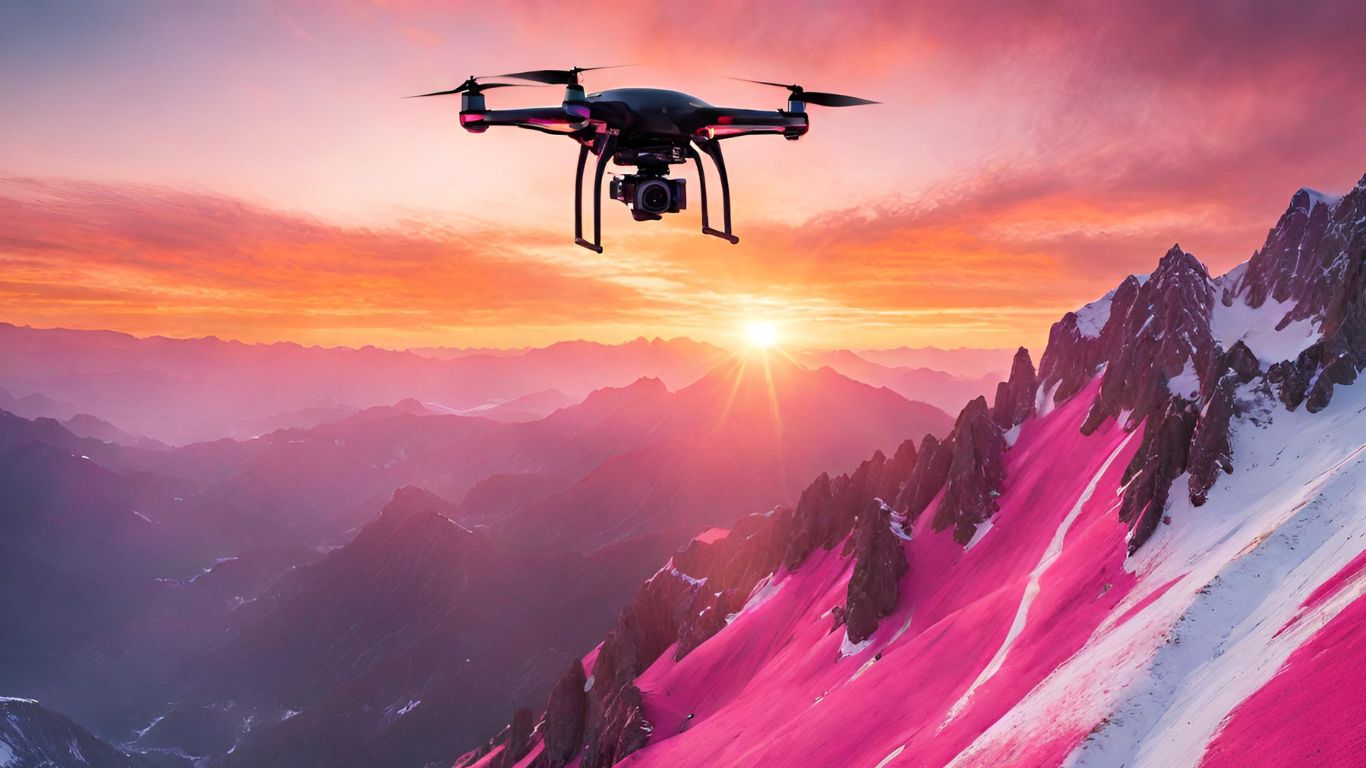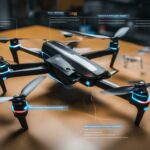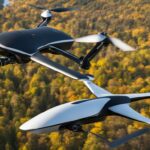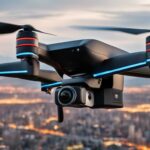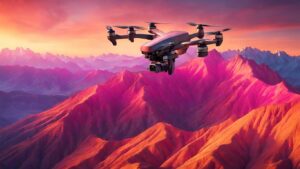
Do drones have cameras? Yes, drones can be equipped with cameras. This doesn’t mean that all drones have cameras. Drone cameras have revolutionized the world of aerial photography, captivating both hobbyists and professionals alike. These technologically advanced devices equipped with high-quality cameras have opened up a new realm of possibilities, allowing users to capture stunning aerial views and perspectives like never before.
From filmmakers seeking breathtaking shots to real estate agents showcasing properties from unique angles, drone cameras have become indispensable tools in various industries. With features such as image stabilization and adjustable settings, these cameras ensure smooth and clear footage, even in challenging conditions.
Key Takeaways: Do Drones Have Cameras
- Camera-equipped drones have become popular among hobbyists, photographers, and videographers, offering high-quality cameras for capturing aerial footage and images.
- Consumer and professional drone camera technology has advanced significantly, with features like 4K resolution, image stabilization, and obstacle avoidance, enhancing the user experience.
- Cameras on drones have various applications in industries such as filmmaking, real estate, and agriculture, enabling stunning aerial views, remote monitoring, mapping, and surveying.
- Drone cameras have limitations such as limited battery life, size and weight impacting flight performance, and challenges in low-light and weather conditions, but future developments aim to improve resolution, low-light performance, and incorporate advanced technologies like artificial intelligence and virtual reality.
The Evolution of Camera-Equipped Drones
With advancements in camera technology and the increasing demand for high-quality aerial footage, camera-equipped drones have undergone a remarkable evolution. These drones have had a significant impact on the film industry, revolutionizing the way filmmakers capture breathtaking shots. The ability to capture unique perspectives and stunning aerial views has opened up a world of creative possibilities for filmmakers, allowing them to tell stories from a whole new angle.
However, the use of drones with cameras for surveillance raises ethical concerns. Privacy issues arise when drones are used to gather sensitive information or invade personal spaces. Striking a balance between the benefits of drone camera technology and the ethical implications of surveillance is crucial in ensuring responsible and respectful use of this powerful tool.
Advancements in Consumer Drone Camera Technology
Consumer drone camera technology has seen significant advancements in recent years, allowing enthusiasts and hobbyists to capture high-quality aerial footage like never before. These advancements have had a profound impact on the photography industry, revolutionizing the way professionals and amateurs alike approach their craft. Here are some key points to consider:
- The impact of drone cameras on the photography industry:
- Drone cameras have opened up new creative possibilities, allowing photographers to capture unique perspectives and stunning aerial shots.
- They have made aerial photography more accessible and affordable, eliminating the need for expensive helicopter rentals or specialized equipment.
- Drone cameras have also sparked new genres of photography, such as drone racing and aerial panoramas.
- The potential of drone cameras in wildlife conservation:
- Drones equipped with cameras have become valuable tools for wildlife researchers and conservationists.
- They enable aerial surveys of animal populations, helping to monitor and protect endangered species.
- Drone cameras can also be used to document wildlife behavior and habitat changes, providing valuable data for scientific research and conservation efforts.
With ongoing advancements in consumer drone camera technology, the possibilities for aerial photography and wildlife conservation continue to expand, promising exciting developments in the future.
The Rise of Professional Drone Cameras
Professional drone cameras have revolutionized the field of aerial photography and videography, providing advanced features and capabilities for capturing high-quality footage. These cameras have found numerous applications in professional cinematography, allowing filmmakers to capture breathtaking aerial shots that were previously difficult or impossible to achieve.
The impact of drone cameras on the real estate industry has been significant as well. Real estate agents and property developers now use drone cameras to capture stunning aerial views of properties, showcasing them in a more immersive and engaging way. This has proven to be a game-changer in the industry, attracting more potential buyers and giving them a better understanding of the property’s layout and surroundings.
With their versatility and technological advancements, professional drone cameras continue to push the boundaries of what is possible in aerial photography and videography.
The Versatility of Cameras on Drones
The adaptability of cameras on drones allows for a wide range of applications and creative possibilities in aerial photography and videography.
- Creative applications: Unleashing the artistic potential of drone cameras.
- Drone cameras give photographers and videographers the ability to capture unique and breathtaking aerial shots, opening up new creative possibilities.
- With the ability to fly and maneuver in different directions, drones enable photographers and videographers to explore new angles and perspectives.
- Aerial photography and videography with drones can be used in various creative projects such as films, music videos, and documentaries.
- Safety and regulations: Ensuring responsible and legal use of drone cameras.
- It is important to adhere to safety guidelines and regulations when operating drone cameras to prevent accidents and ensure the safety of people and property.
- Many countries and regions have specific rules and regulations regarding drone use, including restrictions on flying in certain areas or at certain altitudes.
- It is essential for drone operators to be aware of and comply with these regulations to avoid legal issues and potential fines.
Exploring Different Types and Features of Drone Cameras
As we delve into the world of drone cameras, it is important to explore the different types and features they offer.
One aspect to consider is the comparison of camera stabilization systems on different drone models. Some drones are equipped with advanced gimbal stabilization systems that help capture smooth and steady footage, even in windy conditions.
Another crucial factor is the impact of different camera sensors on image quality in drone photography. Drones can be equipped with various types of camera sensors, such as DSLR, mirrorless, or action cameras. The size and quality of the sensor can greatly affect the clarity, color accuracy, and dynamic range of the images captured.
It is essential to choose a drone camera with a sensor that suits your specific photography needs.
Limitations and Challenges of Drone Camera Technology
However, despite the advancements in drone camera technology, there are still limitations and challenges that need to be addressed.
- The impact of drone camera technology on the film industry:
- Drone cameras have revolutionized aerial cinematography, providing filmmakers with unique and stunning perspectives.
- They have made it easier and more affordable to capture aerial footage, eliminating the need for expensive helicopter rentals.
- However, there are still challenges in terms of safety and regulations, as filmmakers need to ensure they comply with airspace restrictions and obtain necessary permits.
- The ethical considerations of using drone cameras in surveillance:
- Drone cameras have the potential to be used for surveillance purposes, raising concerns about privacy and invasion of personal space.
- There is a need for clear guidelines and regulations to prevent abuse and ensure that drone cameras are used responsibly.
- Balancing the benefits of surveillance for public safety with the protection of individual privacy rights is a significant challenge that needs to be addressed.
The Future of Drone Cameras: Innovations and Trends
Continuously evolving, drone cameras are at the forefront of technological advancements and are poised to revolutionize the field of aerial photography and videography. Future developments in drone camera technology hold immense potential for improving the capabilities and performance of these devices.
One significant trend in the future of drone cameras is the impact of artificial intelligence (AI). AI algorithms can enable advanced object tracking and recognition, enhancing the overall user experience and opening up new possibilities for creative aerial shots.
Additionally, advancements in image sensors and image processing will further improve the image quality and low-light performance of drone cameras. The development of smaller and lighter camera modules will also contribute to the creation of more compact and agile drones.
As technology continues to progress, the future of drone cameras looks promising, with exciting innovations and trends on the horizon.
Pushing the Boundaries: Drone Cameras in Extreme Sky Adventures
One of the most exhilarating applications of drone cameras is their use in extreme sky adventures, where they capture heart-racing moments from daring activities such as skydiving, base jumping, and wingsuit flying. These adrenaline-fueled experiences are taken to new heights with the help of drone cameras, providing a unique perspective that was previously inaccessible.
Here are some ways in which drone cameras are pushing the boundaries in extreme sky adventures:
- The adrenaline rush: extreme sports captured by drone cameras
- Drone cameras capture breathtaking aerial footage of skydivers freefalling through the clouds, capturing their thrilling descent and parachute deployment.
- Base jumpers leaping off tall buildings or cliffs are visualized from above, showcasing their daring and precise maneuvers.
- Wingsuit flyers soaring through the air like birds can be filmed from a close distance, capturing their graceful movements and the scenic landscapes they fly over.
- Uncharted territories: drone cameras in wildlife exploration
- Drone cameras are used to document wildlife in their natural habitats, providing a non-intrusive way to study and observe animals from above.
- They allow for close-up views of animals in their natural environment, providing valuable insights into their behavior and interactions.
- Drone cameras can capture footage of animals in remote and inaccessible areas, allowing researchers and conservationists to explore uncharted territories and discover new species.
Capturing Thrilling Moments: Aerial Photography and Videography With Drone Cameras
Using their advanced capabilities, drone cameras capture thrilling moments from unique aerial perspectives. They have revolutionized the photography and videography industry, allowing for creative storytelling through the capture of stunning aerial views.
Drone cameras provide a fresh and captivating way to engage audiences, as they offer a unique and immersive experience. With the ability to fly and maneuver in ways that traditional cameras cannot, drone cameras enable photographers and videographers to capture breathtaking shots that were previously impossible. This has had a profound impact on the industry, opening up new possibilities for filmmakers, real estate professionals, and content creators.
The use of drone cameras has transformed the way we see the world, providing a fresh and dynamic perspective that adds excitement and intrigue to visual storytelling.
Frequently Asked Questions
Are There Any Regulations or Restrictions on Using Camera-Equipped Drones?
Regulations and restrictions on camera-equipped drones vary by country and region. These measures aim to ensure safety, protect privacy, and prevent unauthorized surveillance. Drone cameras have raised concerns regarding privacy and security, leading to the development of guidelines and laws to govern their use.
What Are Some Common Industries or Applications That Use Drones With Cameras?
Drones with cameras are commonly used in the real estate industry to capture stunning aerial views of properties, showcasing their features and surroundings. In agriculture, camera-equipped drones provide benefits such as crop monitoring, field analysis, and precision spraying.
What Are the Different Types of Cameras That Can Be Used on Drones?
There are various types of cameras that can be used on drones, including DSLR, mirrorless, and action cameras. Each type has its own benefits and limitations. Popular drone camera brands include DJI, GoPro, and Sony.
How Does the Size and Weight of a Drone Camera Affect Its Performance?
The size and weight of a drone camera can significantly impact its performance. Factors such as flight performance, maneuverability, and battery life can be affected. Additionally, the size and weight may also influence the image quality and stability of the footage captured.
What Advancements or Developments Can We Expect to See in the Future of Drone Camera Technology?
Future advancements in drone camera technology will likely include higher-resolution cameras, improved low-light performance, and AI-powered object tracking. These developments will have a significant impact on the quality and capabilities of aerial photography, enhancing the immersive experience for users.
Conclusion
In conclusion, drone cameras have revolutionized the field of aerial photography and videography, offering users the ability to capture stunning aerial views and perspectives. With advancements in technology, these cameras have become indispensable tools in various industries, allowing filmmakers, real estate agents, and others to showcase their work from unique angles.
Despite limitations such as battery life and size, ongoing research and development are addressing these challenges. As the future unfolds, the integration of artificial intelligence and virtual reality holds promising potential for even more thrilling and immersive sky adventures.


